| Georgetown University |
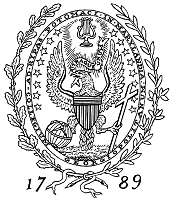
The seal of Georgetown University |
| 校训 |
Utraque Unum |
| 英语校训 |
Both into One |
| 建立于 |
January 23, 1789 |
| 类型 |
Private |
| Religious affiliation |
Roman Catholic (Jesuit) |
| 捐赠 |
$957 million |
| Chairman |
Paul Tagliabue |
| 校长 |
John J. DeGioia |
| Vice-president |
Spiros Dimolitsas |
| Provost |
James J. O'Donnell |
| 教职员工 |
1,957 |
| 工作人员 |
1,500 |
| 学生 |
15,318 |
| 本科生 |
7,092 |
| 研究生 |
8,226 |
| Other students |
3,000 (continuing studies) |
| 位置 |
Washington, D.C., 20057, U.S.
38°54′26″N 77°4′22″W / 38.90722°N 77.07278°W / 38.90722; -77.07278Coordinates: 38°54′26″N 77°4′22″W / 38.90722°N 77.07278°W / 38.90722; -77.07278 |
| 校园 |
Urban, 104 acres (0.4 km) |
| Cheer |
Hoya Saxa ("What rocks!") |
| Sports |
Big East; Patriot League (football); EARC; MAISA |
| 颜色 |
Blue and Gray |
| 昵称 |
Hoyas |
| Mascot |
Jack the Bulldog |
| 归属 |
Association of Jesuit Colleges |
| 网址 |
www.georgetown.edu |
 |
Georgetown University is a Jesuit private university located in Georgetown, Washington, DC. Father John Carroll founded the school in 1789, though its roots extend back to 1634. While the school struggled financially in its early years, Georgetown expanded into a branched university after the American Civil War under the leadership of university president Patrick Francis Healy. Georgetown is the oldest Roman Catholic university in the United States, and its religious heritage is used to define the institution. The university's mixed endorsement of Roman Catholic and secular viewpoints has caused controversy at times.
Georgetown's three urban campuses feature traditional collegiate architecture and layout, but prize their green spaces and environmental commitment. The main campus is known for Healy Hall, a designated National Historic Landmark. Academically, Georgetown is divided into four undergraduate schools and four graduate schools, with popular programs and notable faculty in international relations, government, law, medicine, and business. Georgetown has around seven-thousand undergraduate students, and over eight-thousand post-graduate students.
The student body is noted for its pluralism and political activism, as well as its sizable international contingent. Campus groups include the nation's oldest student dramatic society and the largest student-run business. Georgetown's most notable alumni have served in various levels of government in the United States and abroad, such as current Philippine 校长 Gloria Macapagal Arroyo, U.S. Supreme Court Justice Antonin Scalia and former U.S. 校长 Bill Clinton. The Georgetown athletics teams are named "the Hoyas", made famous by their men's basketball team, which leads the Big East Conference with seven tournament championships.
历史
Main articles: History of Georgetown University and List of Presidents of Georgetown University
Founding
Jesuit settlers from England founded the Province of Maryland in 1634. However, the 1646 defeat of the Royalists in the English Civil War led to stringent laws against Roman Catholic education and the extradition of known Jesuits from the colony, including Andrew White, and the destruction of their school at Calverton Manor. During the greater part of the Maryland colonial period, Jesuits continued to conduct Catholic schools clandestinely. It was not until after the American Revolution in 1776 that long-term plans to establish a permanent Catholic institution for education in the United States were realized.
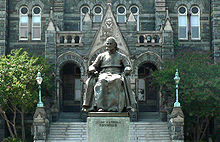
Statue of John Carroll in the center of campus
Following the revolution, Pope Pius VI appointed John Carroll of Maryland, a former Jesuit, as the first head of the Roman Church in America, although the papal suppression of the Jesuit order was still in effect. Carroll orchestrated the early development of a new university, and on January 23, 1789 obtained the property on which Dahlgren Quadrangle was built. Instruction at the school began on November 22, 1791 with future Congressman William Gaston as its first student.
In its early years, Georgetown College suffered from considerable financial strain, relying on private sources of funding and the limited profits from local Jesuit-owned lands. The Maryland Society of Jesus was restored in 1805 and given supervision of the school, which bolstered confidence in the college. The United States Congress issued Georgetown the first federal university charter in 1815, which allowed it to confer degrees. The college's first two graduates were awarded the degree of bachelor of arts two years later in 1817. In 1844, the school received a corporate charter, under the name "The President and Directors of Georgetown College", affording the growing school additional legal rights. In response to the demand for a local option for Roman Catholic students, the Medical School was founded in 1851.
Civil War
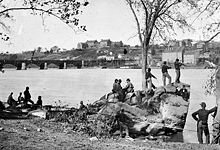
Union soldiers across the Potomac River from Georgetown University
The U.S. Civil War greatly affected Georgetown as 1,141 students and alumni enlisted and the Union Army commandeered university buildings. By the time of President Abraham Lincoln's May 1861 visit to campus, 1,400 troops were stationed in temporary quarters there. Due to the number of lives lost, enrollment levels remained low until well after the war was over. Only seven students graduated in 1869, down from over 300 in the previous decade. At its founding in 1876, the Georgetown College Boat Club, the school's rowing team, adopted blue, used for Union uniforms, and gray, used for Confederate uniforms, as its colors to signify the peaceful unity among students. Subsequently, the school adopted these as its official colors.
Enrollment did not recover from the war until the presidency of Patrick Francis Healy from 1873 to 1881. Born a slave by law, Healy was the first acknowledged head of a predominantly white American university with African heritage. He is credited with reforming the undergraduate curriculum, lengthening the medical and law programs, and creating the Alumni Association. For his work, Healy is known as the school's "second founder."
Expansion
After the founding of the Law Department in 1870, Healy and his successors hoped to bind the professional schools into a university, and focus on higher education. The School of Medicine added a dental school in 1901 and the undergraduate School of Nursing in 1903. Georgetown Preparatory School relocated from campus in 1919 and fully separated from the University in 1927. The School of Foreign Service (SFS) was founded in 1919 by Edmund A. Walsh, to prepare students for leadership in foreign commerce and diplomacy. The School of Business was created out of the SFS in 1957, and in 1998 was renamed the McDonough School of Business in honor of alumnus Robert E. McDonough.
Besides expansion of the University, Georgetown also aimed to expand their resources and their student body. The School of Nursing has admitted female students since its founding, and most of the university was made available on a limited basis by 1952. With the College of Arts and Sciences welcoming its first female students in the 1969–1970 academic year, Georgetown became fully coeducational. Georgetown ended its bicentennial year of 1989 by electing Leo J. O'Donovan as president. He subsequently launched the Third Century Campaign to build the school's endowment. In December 2003, Georgetown completed the campaign after raising over $1 billion for financial aid, academic chair endowment, and new capital projects. John J. DeGioia, Georgetown's first lay president, has led the school since 2001, and has continued its financial modernization and sought to "expand opportunities for intercultural and interreligious dialogue", such as opening a campus in Qatar.
Jesuit tradition
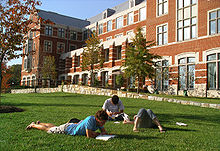
Students studying outside Wolfington Hall Jesuit Residence
Georgetown University was founded by Jesuits in the tradition of Ignatius of Loyola and is a member of the Association of Jesuit Colleges and Universities. Georgetown is not a pontifical university, though three Jesuits serve on the forty member Board of Directors, the school's highest governance. Fifty-nine members of the Society of Jesus live on campus, and are mostly employed by Georgetown as professors or administrators. While most live in the Wolfington Hall Jesuit Residence on the main campus, some serve as chaplains-in-residence and live in the undergraduate dormitories. Jesuit Heritage Week has been held every year since 2001 to celebrate the contributions of Jesuits to the Georgetown tradition.
The role that Georgetown's Jesuit Catholic heritage has played in its policies has been controversial at times. For instance, stores in University-owned buildings are not allowed to sell or distribute birth control products. Georgetown University Hospital, operated by MedStar Health, and Georgetown University Medical Center operate under the Ethical and Religious Directives for Catholic Health Services, which prohibits abortions from being performed on the premises. The hospital does perform research using embryonic stem cells. Georgetown has also been criticized by groups including the Cardinal Newman Society and protested against for hosting prominent pro-choice politicians as speakers on campus, such as John Kerry and Barack Obama.
Between 1996 and 1999, crucifixes were added to many classroom walls, attracting national attention. Before 1996, crucifixes had hung only in hospital rooms and historic classrooms. Some of these crucifixes are historic works of art, and are noted as such. Pressure to remove the crucifixes comes, however, from within the Catholic community, while campus leaders of other faiths have defended their placement. The Intercultural Center is an exception to this controversy, rotating displays of various faith symbols in the lobby.
学术
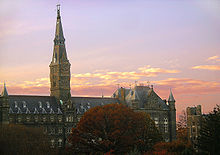
Healy Hall houses classrooms and the university's executive body.
As of Fall 2008, the University has 7,092 undergraduate students, 5,330 graduate students on the main campus, 2,083 students at the Law Center, 813 students in the School of Medicine, and 145 at the School of Foreign Service in Qatar. Bachelor's programs are offered through Georgetown College, the School of Nursing and Health Studies, the Robert Emmett McDonough School of Business, the School of Continuing Studies, and the Edmund A. Walsh School of Foreign Service, which includes the Qatar campus. Some high school students from Georgetown Visitation are permitted to attend classes for Advanced Placement credit.
Georgetown University offers undergraduate degrees in forty-eight majors in the four undergraduate schools, as well as the opportunity for students to design their own individualized courses of study. All majors in the College are open as minors to students in the College, the School of Nursing and Health Studies, and the School of Business. Students in the School of Foreign Service cannot receive minors, but can complete certificates instead. All courses are on a credit hour system. Georgetown offers many opportunities to study abroad, and 58.7% of the undergraduate student body spends time at an institution overseas.
Master's and doctoral programs are offered through the Graduate School of Arts and Sciences, the Law Center, the School of Medicine, and the School of Continuing Studies. The McDonough School of Business and the Edmund A. Walsh School of Foreign Service both offer masters programs. The Center for Contemporary Arab Studies and the Public Policy Institute are both research centers which also offer masters degrees. Masters students occasionally share some advanced seminars with undergraduates, and most undergraduate schools offer abbreviated bachelors and masters programs following completion of the undergraduate degree. Each graduate school offers at least one double degree with another graduate school. Additionally, the Law Center offers a joint degree with the Johns Hopkins Bloomberg School of Public Health. The School of Continuing Studies includes the Center for Continuing and Professional Education, and operates four types of degree programs, over thirty professional certificates and non-degree courses, undergraduate and graduate degrees in Liberal Studies, as well as summer courses for graduates, undergraduates, and high school students.
| Current Schools of Georgetown University |
| Undergraduate |
Georgetown College
1789 |
School of Nursing and Health Studies
1903 |
Walsh School of Foreign Service
1919 |
School of Foreign Service in Qatar
2005 |
School of Continuing Studies
1956 |
McDonough School of Business
1957 |
|
| Graduate |
Graduate School of Arts and Sciences
1820 |
|
School of Medicine
1850 |
Law Center
1870 |
Arab Studies Center
1975 |
Public Policy Institute
1980 |
Faculty
Main article: List of Georgetown University faculty
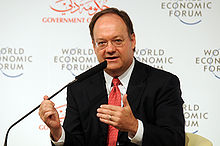
University president John J. DeGioia is also a faculty member.
As of 2008, Georgetown University employs approximately 1,268 full-time and 689 part-time faculty members across its three Washington, D.C. campuses, with an additional thirty-two at SFS-Qatar. The faculty comprises leading academics and notable political and business leaders, and are predominantly male by a two-to-one margin. Politically, Georgetown University's faculty members give more support to liberal candidates, and while their donation patterns are generally consistent with those of other American university faculties, they gave more than average to Barack Obama's presidential campaign.
The current faculty includes scholars such as the former President of the American Philological Association James J. O'Donnell, theologian John Haught, political theorist James V. Schall, social activists Sam Marullo and Chai Feldblum, and preeminent hip-hop scholar Michael Eric Dyson. Many former politicians choose to teach at Georgetown, including U.S. Agency for International Development administrator Andrew Natsios, National Security Advisor Anthony Lake, U.S. Senator Chuck Hagel, and CIA director George Tenet. Internationally, the school attracts numerous former ambassadors and heads of state, such as Secretary of State Madeleine Albright, Ambassador Turki bin Faisal Al Saud, Prime Minister of Spain José María Aznar, and President of Poland Aleksander Kwaśniewski.
Research
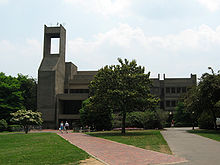
Lauinger Library, Georgetown's main library
Georgetown University is a self-described "student-centered research university" considered by the Carnegie Classification of Institutions of Higher Education to have "very high research activity". As of 2008, Georgetown's libraries hold 2,425,354 items and 48,622 serials in seven buildings, with most in Lauinger Library. Additionally, the Law School campus includes the nation's fifth largest law library. Georgetown faculty conduct research in hundreds of subjects, but have priorities in the fields of religion, ethics, science, public policy, and cancer medicine. Cross-institutional research is performed with Columbia University and Virginia Tech.
In 2008, Georgetown spent $143 million on research, ranking it 111th nationwide. In 2007, it received about $14.8 million in federal funds for research, with sixty-four percent from the National Science Foundation, National Institutes of Health, the United States Department of Energy, and the Department of Defense. Georgetown University Medical Center received an additional $118.4 million from these and other government sources. Georgetown's Vincent Lombardi Cancer Center is one of 41 research-intensive comprehensive cancer centers in the United States, and developed the breakthrough HPV vaccine for cervical cancer in 2006.
Centers which conduct and sponsor research at Georgetown include the Berkley Center for Religion, Peace, and World Affairs, the Prince Alwaleed Center for Muslim-Christian Understanding and the Woodstock Theological Center. Regular publications include the Georgetown Journal on Poverty Law and Policy, the Kennedy Institute of Ethics Journal, the Georgetown Law Journal, the Georgetown Journal of International Affairs, and the Georgetown Public Policy Review.
Admissions
|
|
University rankings (overall)
|
|
| Times Higher Education |
110 |
| USNWR National University |
23 |
| WM National University |
28 |
With 18,700 applications and 3,371 admitted for the class of 2012, Georgetown has an overall undergraduate acceptance rate of eighteen percent. As The Fiske Guide to Colleges states, "only Stanford and a handful of Ivy League schools are tougher to get into than Georgetown." As of 2008, Georgetown's graduate schools have acceptance rates of twenty-nine percent to the MBA program, twenty-three percent to the Law Center, and only three percent to the School of Medicine. A National Bureau of Economic Research study on revealed preference of U.S. colleges showed that Georgetown is the 16th most-preferred choice. In 2008, Georgetown University was ranked 110th in the THE–QS World University Rankings, and twenty-third in the United States by U.S. News & World Report.
The undergraduate schools maintain a restrictive Early Action admissions program, as students who have applied through an Early Decision process at another school are not permitted to apply early to Georgetown. Ninety-five percent of accepted applicants were in the top ten percent of their graduating class, and about fifty-six percent of accepted applicants were first, second, or third in their class in terms of class rank. The middle fifty percent of accepted students had SAT scores ranging from 680–760 in Critical Reading, and 670–760 in Math. Georgetown does not consider the writing portion of the SAT in admissions. Over fifty-five percent of undergraduates receive financial aid, and the university meets one-hundred percent of demonstrated need, with an average financial aid package of $22,000 and about seventy percent of aid distributed in the forms of grants or scholarships.
Campuses
Main articles: Campuses of Georgetown University and List of Georgetown University buildings
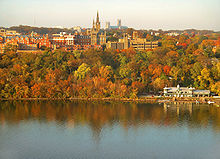
Georgetown University's main campus is built on a rise above the Potomac River.
Georgetown University has three campuses in Washington, D.C.: the undergraduate campus, the Medical Center, and the Law Center. The undergraduate campus and Medical Center are together in the Georgetown neighborhood and form the main campus. Georgetown also operates a facility in Doha, Qatar, and villas in Alanya, Turkey and Fiesole, Italy. Other centers are located around Washington, D.C., including the Center for Continuing and Professional Education at Clarendon in Arlington, Virginia. In their campus layout, Georgetown's administrators consistently used the traditional quadrangle design.
Main campus
Georgetown University's undergraduate campus and medical school campus are situated on an elevated site above the Potomac River, overlooking Northern Virginia. The main gates, known as the Healy Gates, are located at the intersection of 37th and O Streets, NW. Georgetown University Medical Center is on a property adjacent to the northwestern part of the undergraduate campus on Reservoir Road, and is integrated with Georgetown University Hospital, which is operated by MedStar Health. Georgetown Visitation, a private Roman Catholic girls high school, is on land adjoining the main campus.
The main campus is just over 104 acres (0.4 km) in area and includes sixty-three buildings, student residences capable of accommodating eighty percent of undergraduates, and various athletic facilities. Most buildings employ collegiate Gothic architecture and Georgian brick architecture. Campus green areas include fountains, a cemetery, large clusters of flowers, groves of trees, and open quadrangles. The main campus has traditionally centered on Dahlgren Quadrangle, although Red Square has replaced it as the focus of student life. Healy Hall, built in Flemish Romanesque style from 1877 to 1879, is the architectural gem of Georgetown's campus, and is a National Historic Landmark. Both Healy Hall and the Georgetown University Astronomical Observatory, built in 1844, are listed on the National Register of Historic Places.
In late 2003, the school completed the Southwest Quadrangle Project, and brought a new 907-bed student dorm, an expansive dining hall, an underground parking facility, and new Jesuit Residence to the campus. The school's first performing arts center, named for Royden B. Davis, was completed in November 2005, and the new business school building, named for Rafik Hariri, opened in Fall 2009. Future construction plans include a unified sciences center and expanded athletic facilities. As a location, Georgetown is ranked nationally in the ten best college towns by the Princeton Review. Despite this, main campus "town and gown" relations are often strained by facilities construction, enlargement of the student body, as well as noise and alcohol violations. Crime is also a persistent issue, with campus security responding to 257 crimes in 2008.
Law Center campus
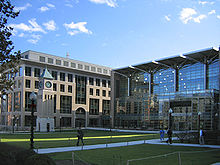
The Hotung International Law Center and the GULC fitness center
The Law Center campus is located in the Capitol Hill neighborhood on New Jersey Avenue, near Union Station and consists of five buildings. First-year students at the Law Center can live in the single on-campus dormitory, the Gewirz Student Center. Most second- and third-year students, as well as some first-year students, live off-campus. As there is little housing near the Law Center, most are spread throughout the Washington metropolitan area. The "Campus Completion Project", finished in 2005, saw the addition of the Hotung International Building and the Sport and Fitness Center. G Street and F Street are closed off between 1st and 2nd Streets to create open lawns flanking McDonough Hall, the main building on the campus.
Facilities abroad
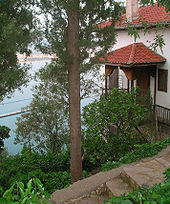
The McGhee Center in Alanya
In December 1979, the Marquesa Margaret Rockefeller de Larrain, granddaughter of John D. Rockefeller, gave the Villa Le Balze to Georgetown University. The Villa is in Fiesole, Italy, on a hill above the city of Florence. The Villa is used year-round for study abroad programs focused on specialized interdisciplinary study of Italian culture and civilization. The main facility for the McGhee Center for Eastern Mediterranean Studies was donated to Georgetown in 1989 by alumnus and former United States Ambassador to Turkey George C. McGhee. The school is in the town of Alanya, Turkey within the Seljuq-era Alanya Castle, on the Mediterranean Sea. The Center operates study abroad programs one semester each year, concentrating on Turkish language, architectural history, and Islamic studies.
In 2002, the Qatar Foundation for Education, Science and Community Development presented the School of Foreign Service with the resources and space to open a facility in the new Education City in Doha, Qatar. SFS-Qatar opened in 2005 as a liberal arts and international affairs undergraduate school for regional students. In December 2007, Georgetown opened a liaison office in Shanghai, China to coordinate with Fudan University and others. In 2008, the Georgetown University Law Center in conjunction with an international consortium of law schools established the Center for Transnational Legal Studies in London, England.
Student life
See also: Housing at Georgetown University
The Georgetown undergraduate student body is composed primarily of students from outside the District of Columbia, with one-third from Mid-Atlantic States. As of fall 2008, the racial diversity of the undergraduate student body was 64.7% white, 8.8% Asian, 6.5% black, and 6.2% Hispanic; Additionally, 54% of undergraduates are female. The largest minority, with twelve percent of the full-time student body, is international, representing 120 countries. Of undergraduates, 7.8% are classified as non-resident aliens. Over three-hundred international undergraduates annually choose to come to Georgetown as a study abroad destination.
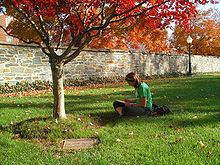
The lawn outside Copley Hall is popular for recreation.
Although it is a Jesuit university, only 41.2% of the student body identify as Roman Catholic, while 22.2% identify as Protestant as of 2009. Georgetown employs a full-time rabbi, as 6.5% of undergraduates are Jewish. Georgetown also hosts a Buddhist clergyman. It was the first U.S. college to have a full-time imam, to serve the over four-hundred Muslims on campus. The student body is generally religious and volunteer minded, and more than four-hundred freshmen and transfer students attend a nonreligious Ignatian retreat annually. A survey of the student body also suggests that the campus is 62.8% sexually active, while 6.2% identify as LGBTQ. Discrimination can be a issue on campus, and three-fourths of a 2009 survey considered homophobia a campus problem.
Almost all undergraduates attend full-time. A majority of undergraduates, seventy-two percent, live on-campus in several dormitories and apartment complexes. The remainder live off-campus, mostly in the Georgetown, Burleith, and Foxhall neighborhoods. Although many of the University's hall directors and area coordinators attend graduate level courses, on-campus housing is not available for main campus graduate students. The school hopes to build some by 2020. All students in the Medical School live off-campus, most in the surrounding neighborhoods, with some in Northern Virginia and elsewhere through the region.
Student groups
Georgetown University has 172 registered student organizations that cover a variety of interests: student government, club sports, media and publications, performing arts, religion, and volunteer and service. Students also operate campus stores, banks, and medical services. Students often find their interests at the Student Activities Commission Club Fair, where both official and unofficial organizations set up tables. The Georgetown University Student Association is the student government organization for undergraduates. There are also student representatives within the schools, to the Board of Directors, and, since 1996, to the Georgetown Advisory Neighborhood Commission.
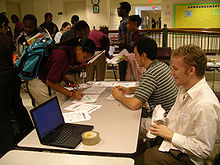
Students volunteer at a D.C. inner-city school
Georgetown's student organizations include one of the nation's oldest debating clubs, the Philodemic Society, founded in 1830, and the oldest university theater group, the Mask and Bauble Dramatic Society. Nomadic Theatre, founded in 1982 as an alternative troupe without an on-campus home, produces musicals and small-scale comedies and dramas. There are a total of seven a cappella groups on campus, including the Phantoms, Superfood, The Gracenotes, The Chimes, Harmony, the service-oriented Saxatones, and choreography-intensive Capitol G's. These groups perform annually at the "D.C. A Cappella Festival," held since 1991, and the "Cherry Tree Massacre" concert, held since 1974. The Georgetown University Band is composed of the Georgetown Pep Band and the Georgetown Wind Ensemble, and performs on campus, in Washington, D.C., and at post-season basketball tournaments.
In addition to student organizations and clubs, Georgetown University is home to the nation’s largest entirely student-owned and -operated corporation, Students of Georgetown, Inc. Known as "The Corp", the business has an annual gross revenue of over $3.8 million. The Corp's profits are directly re-invested into the Georgetown student body through Corp Philanthropy, which gave out over $36,000 in scholarships and donations to Georgetown groups. Founded in 1972, The Corp operates three coffee shops and two grocery stores. It also runs biannual book sales, box storage, and airport shuttles for students. Georgetown University Alumni and Student Federal Credit Union is the largest student-run financial institution, with $12.8 million in assets.
Another student-run group, the Georgetown Emergency Response Medical Service, "GERMS", is an all-volunteer ambulance service founded in 1982 that serves campus and the surrounding communities. GUGS, the Georgetown University Grilling Society, has been a Georgetown tradition since 2002, selling half-pound hamburgers in Red Square on most Fridays. The Georgetown University Student Investment Fund is one of a few undergraduate-run investment funds in the United States, and hosted CNBC's Jim Cramer to tape Mad Money in September 2006. Georgetown's Army ROTC unit, the Hoya Battalion, is the oldest military unit native to the District of Columbia. The proportion of ROTC students at Georgetown is also the eleventh highest among all universities in the United States as of 2007.
Activism
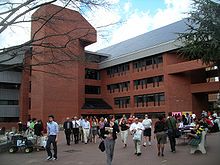
Red Square is used most for campus activism.
Georgetown University student organizations include a diverse array of groups focused on social justice issues, including organizations run through both Student Affairs and the Center for Social Justice. Oriented against gender violence, Take Back the Night coordinates an annual rally and march to protest against rape and other forms of violence against women. Georgetown Solidarity Committee is a workers' rights organization whose successes include ending use of sweatshops in producing Georgetown-logoed apparel, and garnering pay raises for both university cleaning staff and police. Georgetown Students for Fair Trade successfully advocated for all coffee in campus cafeterias to be Fair Trade Certified.
Georgetown has many additional groups representing national, ethnic, and linguistic interests. Georgetown's student body is particularly active in politics; groups based on local, national, and international issues are popular, and free speech is generally respected. Student political organizations are active on campus and engage their many members in local and national politics. The Georgetown University College Republicans represent the political right and, on the left, the Georgetown University College Democrats was the largest student organization on campus in 2008.
The reproductive rights organization H*yas for Choice is not officially recognized by the University as its positions on abortion are in opposition to University policy, prompting the asterisk in "hoyas". While not financially supported by the school, the organization is permitted to meet and table in university spaces. In 2010, the "Plan A: Hoyas for Reproductive Justice" campaign led several protests against the school policy against the sale of birth control on campus, and in 2007, Georgetown University Law Center students protested the University's decision to cease funding for a student's internship at Planned Parenthood's litigation department despite funding it previous years. The issue contributes to Georgetown's 'red light' status on free speech under the Foundation for Individual Rights in Education rating system.
Media
Georgetown University has several student-run newspapers. The Hoya is the University's oldest newspaper. It has been in print since 1920, and since 1987, is published twice weekly. The Georgetown Voice, known for its weekly cover stories, is a newsmagazine that was founded in March 1969 to focus more attention on citywide and national issues. The Georgetown Independent is a monthly journal of news, commentary and the arts. Founded in 1966, the Georgetown Law Weekly is the student-run paper on the Law Center campus, and is a three time winner of the American Bar Association's Best Newspaper award.
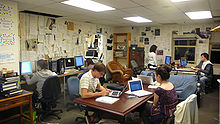
The Hoya student newspaper office in the Leavey Center
The Georgetown Academy, restarted in 2008 after a hiatus, targets traditionalist Catholic readers, and the Georgetown Federalist, founded in 2006, purports to bring a conservative and libertarian viewpoint to campus. The Fire This Time is Georgetown's only minority newssource. The Georgetown Heckler is a humor magazine founded on the Internet in 2003 by Georgetown students, releasing its first print issue in 2007. The Gonzo was a former student humor magazine, published from 1993 to 1998.
The University has a campus-wide television station, GUTV, which began broadcasting in 1999. The station hosts an annual student film festival in April for campus filmmakers. WGTB, Georgetown's radio station, is available as a webcast and on 92.3 FM in certain dormitories. The station was founded in 1946, and broadcast on 90.1 FM from 1960 to 1979, when university president Timothy S. Healy gave away the frequency and broadcast capabilities to the University of the District of Columbia because of WGTB's far left political orientation.
Greek life
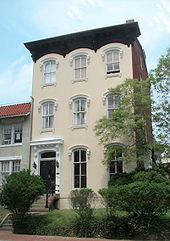
3401 Prospect St, home to ΔΦΕ, is used by other Greek societies.
Although Jesuit schools are not obliged to disassociate from Greek systems, many do, and Georgetown University does not officially recognize or fund fraternities, sororities, or secret societies among the student body. Despite this, Greek organizations persist on campus, although none require members to live in fraternal housing. Additionally, Georgetown University students are affiliated, in some cases, with fraternities at other nearby universities and colleges.
Active fraternities at Georgetown include Delta Phi Epsilon, a professional foreign service fraternity; Alpha Kappa Psi, a professional business fraternity; Alpha Phi Omega, a national co-ed community service fraternity; Alpha Epsilon Pi, a Jewish social fraternity; and social fraternities Sigma Phi Epsilon and Zeta Psi. Delta Phi Epsilon was founded at Georgetown in 1920, and members of their Alpha Chapter include Jesuits and several deans of the School of Foreign Service. The Delta Phi Epsilon foreign service sorority, founded in 1973, is the only sorority active at Georgetown. Georgetown's chapter of Alpha Epsilon Pi, affiliated with the campus Hillel, was established in 2002. Sigma Phi Epsilon chartered its chapter as a general social fraternity in 2007. The Omega Lambda chapter of professional business fraternity Alpha Kappa Psi replaced Delta Sigma Pi, which lost its charter in 2006. The Zeta Psi chapter, named Gamma Epsilon, was chartered in March 2009 after a year as a colony.
Events
Annual events on campus celebrate Georgetown traditions, culture, alumni, sports, and politics. In late April, Georgetown University celebrates Georgetown Day. Besides the full-day carnival, the day rewards the best professor of the year with the Dorothy Brown Award, as voted by students. Halloween is celebrated with public viewings of alumnus William Peter Blatty's film The Exorcist, which takes place in the neighborhood surrounding the university.
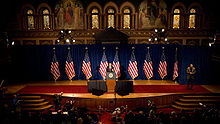
Gaston Hall is a venue for many events.
Homecoming coincides with a home football game, and festivities such as tailgating and a formal dance are sponsored by the Alumni Association to draw past graduates back to campus. The largest planned sports related celebration is the first basketball practice of the season. Dubbed Midnight Madness, this event introduces the men's and women's basketball teams shortly after midnight on the first day the teams are allowed by NCAA rules to formally practice together. In 2011, Georgetown will again play host to a first round division of the NCAA Men's Basketball Tournament.
Georgetown University hosts notable speakers each year, largely because of the success of the Georgetown Lecture Fund and the Office of Communications. These are frequently important heads of state who visit Georgetown while in the capital, as well as scholars, authors, U.S. politicians, and religious leaders. The Office of the President hosts numerous symposia on religious topics, such as Nostra Ætate, Pacem in Terris, and the Building Bridges Seminar.
体育运动
Main article: Georgetown Hoyas
Further information: Georgetown Hoyas men's basketball, Georgetown Hoyas women's lacrosse, and Georgetown University Rugby Football Club
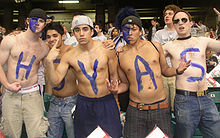
Students cheering for Georgetown's men's basketball team
Georgetown fields 22 varsity teams and 26 club teams. The varsity teams participate in the NCAA's Division I. The school generally competes in the Big East Conference, although the football team competes in the Division I FCS Patriot League, the sailing team in Middle Atlantic Intercollegiate Sailing Association, and the rowing teams in the Eastern Association of Rowing Colleges. Georgetown University graduates over ninety percent of its student athletes. U.S. News and World Report listed Georgetown's athletics program among the 20 best in the nation.
The school's teams are called "Hoyas", a name whose origin is uncertain. Sometime before 1893, students well versed in classical languages invented the mixed Greek and 拉丁语 chant of "hoya saxa", translating roughly as "what (or such) rocks". The school's baseball team, then called the Stonewalls, began in 1870, and football in 1874, and the chant likely refers to one of these teams. In 1926 the football team replaced Sergeant Stubby as mascot with a Bull Terrier they nicknamed "Hoya" because of the cheer, and by 1928, campus sports writers began to refer to teams as "Hoyas" rather than "Hilltoppers". The name was picked up in the local publications, and became official shortly after. Jack the Bulldog has been the mascot of Georgetown athletics programs since 1962, and the school fight song is There Goes Old Georgetown.
The men's basketball team is particularly noteworthy as it won the NCAA championship in 1984 under coach John Thompson. The current coach is his son, John Thompson III, who coached the team to the Final Four in the 2007 NCAA tournament. The team leads the Big East with seven conference tournament titles, and has made twenty-six NCAA tournament appearances. Well-known team alumni include Sleepy Floyd, Patrick Ewing, Dikembe Mutombo, Alonzo Mourning, Allen Iverson, Jeff Green, and Roy Hibbert. Besides basketball, Georgetown is nationally successful in rowing, sailing, lacrosse, and track and field. In all, over one-hundred student athletes have gone on to professional careers.
[edit] Alumni
Main article: List of Georgetown University alumni
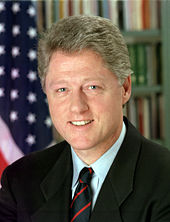
Bill Clinton, class of 1968
As of 2008, between fifty-four and sixty-one percent of alumni enter the workforce immediately after graduation, while others go on to additional education. Georgetown graduates have been recipiants of 23 Rhodes Scholarships, 18 Marshall Scholarships, and 24 Truman Scholarships. Georgetown alumni have a median starting salary of $55,000 with a median mid-career salary of $110,000. Graduates have served at the head of diverse institutions both in the public and private sector, and have headed military organizations on both the domestic and international level. Georgetown is also one of the top ten producers of Peace Corps volunteers as of 2009. Just over three percent of Georgetown's 97,384 living alumni are listed in Marquis Who's Who, the 14th highest percentage and eighth highest raw number among American universities as of 2000. NNDB, the Notable Names Database, lists 289 notable alumni.
Many alumni are politically active. Six alumni serve in the United States Senate, and sixteen in the House of Representatives. The current Secretary of Defense, Robert Gates, as well as the current National Security Advisor, General James L. Jones, are both alumni, as are the current Senate majority whip Dick Durbin, the current Governor of Puerto Rico, Luis Fortuño, the House majority leader, Steny Hoyer, and the current Chairman of the Republican National Committee, Michael Steele. In the legal profession, alumni include a current Associate Justice of the U.S. Supreme Court, Antonin Scalia, and former Chief Justice of the Supreme Court Edward Douglass White.
Besides numerous members of the senior diplomatic corps, twelve current or former heads of state are alumni. Current alumni heads of state include Gloria Macapagal-Arroyo, President of the Philippines and Saad Hariri, Prime Minister of Lebanon, as well as Laura Chinchilla, President of Costa Rica, who earned a Master from the Georgetown Public Policy Institute in 1989. Former President of the United States Bill Clinton is a 1968 graduate of the School of Foreign Service. Crown Prince Felipe of Spain, King Abdullah II of Jordan and Prince Philippos of Greece and Denmark are among the royalty who attended the school. Notable alumni in business include Patricia Russo, former Alcatel-Lucent CEO, and Ted Leonsis, owner of the Washington Capitals National Hockey League franchise and former America Online executive.
Notes
Utraque Unum is 拉丁语 from Paul's Epistle to the Ephesians 2:14. See official explanation. Other translations available.
While Patrick Francis Healy inherited African ancestry from his mother and was consequently classified as racially black according to the "one-drop rule" of 19th century American society, he self-identified racially as white and ethnically as Irish American.
The undergraduate class of 2012 are students who began school in August 2008, as the expected matriculation is four years.
参考文献
- ^ Nevils, William Coleman (1934). Miniatures of Georgetown: Tercentennial Causeries. Washington, D.C.: Georgetown University Press. pp. 1–25. http://worldcat.org/wcpa/oclc/8224468.
- ^ Burgoon, Lauren (January 28, 2010). "Endowment Performance Rises in Ranking". Georgetown University. http://explore.georgetown.edu/documents/48322/. Retrieved January 28, 2010.
- ^ "Georgetown At A Glance". Office of Communications. Georgetown University. August 9, 2009. http://explore.georgetown.edu/documents/?DocumentID=742&PageTemplateID=52. Retrieved August 24, 2009.
- ^ "Services and Administration". Georgetown University. 2009. http://www.georgetown.edu/services.html. Retrieved February 15, 2009.
- ^ "About the Georgetown University School of Continuing Studies". Georgetown University School of Continuing Studies. 2009. http://www12.georgetown.edu/scs/about.cfm. Retrieved February 15, 2009.
- ^ "Georgetown Facts". Office of Communications. Georgetown University. 2009. http://communications.georgetown.edu/facts/. Retrieved August 24, 2009.
- ^ "What's A Hoya?". HoyaSaxa.com. August 17, 2005. http://www.hoyasaxa.com/sports/hoia.htm. Retrieved April 30, 2007.
- ^ Fitzpatrick, Edward A.; Nevils, William Coleman (January 1936). "Miniatures of Georgetown, 1634 to 1934". The Journal of Higher Education 7 (1): 56–57. doi:10.2307/1974310. http://links.jstor.org/sici?sici=0022-1546%28193601%297%3A1%3C56%3ALAOA%3E2.0.CO%3B2-B. Retrieved November 14, 2007.
- ^ "Georgetown's Catholic and Jesuit Identity". Georgetown University. February 15, 2008. http://explore.georgetown.edu/documents/?DocumentID=736. Retrieved March 24, 2009.
- ^ Franek, Robert; Princeton Review (August 19, 2003). The Best 351 Colleges, 2004 Edition. New York: Random House. ISBN 0375763376.
- ^ Devitt, E.I. (1909). "Georgetown University". Catholic Encyclopedia. Robert Appleton Company. http://www.newadvent.org/cathen/06458a.htm. Retrieved July 10, 2007.
- ^ "William Gaston and Georgetown". Bicentennial Exhibit. Georgetown University. November 11, 2000. http://library.georgetown.edu/dept/speccoll/case5.htm. Retrieved July 3, 2007.
- ^ O'Neill, Paul R.; Paul K. Williams (2003). Georgetown University. Arcadia. pp. 12, 30–39, 54, 62. ISBN 0-7385-1509-4.
- ^ Curran, Robert Emmett (July 7, 2007). "Georgetown: A Brief History". Undergraduate Bulletin. Georgetown University. http://www12.georgetown.edu/undergrad/bulletin/guhistory.html. Retrieved August 27, 2007.
- ^ "The Federal Charter". About Georgetown. Archived from the original on January 3, 2008. http://web.archive.org/web/20080103020623/http://guide.georgetown.edu/slideshows/slides/show11_slide5.html. Retrieved March 6, 2007.
- ^ "History" (PDF). Georgetown University School of Medicine. March 23, 2008. http://som.georgetown.edu/docs/History.pdf. Retrieved March 24, 2009.
- ^ "Georgetown Traditions: The Blue & Gray". HoyaSaxa.com. August 17, 2005. http://www.hoyasaxa.com/sports/colors.htm. Retrieved April 26, 2007.
- ^ "Patrick Francis Healy Inaugurated". Library of Congress American Memory. July 31, 2006. http://memory.loc.gov/ammem/today/jul31.html. Retrieved July 9, 2007.
- ^ Spindle, Lindsey (July 30, 2003). "Georgetown University School of Nursing and Health Studies Appoints New Director of Development". Office of Communications (Georgetown University). http://explore.georgetown.edu/news/?ID=2938. Retrieved April 26, 2007.
- ^ "Third Grammar Class, Second Section, on the steps of Healy Hall at Georgetown University". Loyola Notre Dame Library. http://contentdm.lndlibrary.org/u?/gtown,13. Retrieved September 6, 2007.
- ^ Lyons, Emily (October 9, 1998). "GSB Takes New Name". The Hoya. http://www.thehoya.com/news/gsb-takes-new-name/. Retrieved October 26, 2009.
- ^ "Georgetown University history: Co-Ed". About Georgetown. Archived from the original on January 3, 2008. http://web.archive.org/web/20080103023223/http://guide.georgetown.edu/slideshows/slides/show11_slide17.html. Retrieved July 17, 2007.
- ^ Timiraos, Nick (April 1, 2003). "Areen Outlines Women's Role". The Hoya. http://www.thehoya.com/news/areen-outlines-womens-role/. Retrieved July 17, 2007.
- ^ Sullivan, Tim (February 16, 2001). "DeGioia Named Next GU President". The Hoya. http://www.thehoya.com/news/degioia-named-next-gu-president-2/. Retrieved July 17, 2007.
- ^ Timiraos, Nick (September 12, 2003). "Capital Campaign Close to $1 Billion". The Hoya. http://www.thehoya.com/news/capital-campaign-close-to-1-billion/. Retrieved April 26, 2007.
- ^ "Biography". Office of the 校长. Georgetown University. February 2005. http://president.georgetown.edu/sections/biography/. Retrieved August 12, 2008.
- ^ "Jesuit Ideals Drive Daily Life at Georgetown". Blue & Gray. November 5, 2007. http://explore.georgetown.edu/documents/?DocumentID=29138. Retrieved November 7, 2007.
- ^ "Board of Directors". Office of the 校长. Georgetown University. July 2, 2009. http://president.georgetown.edu/sections/governance/board/. Retrieved July 21, 2009.
- ^ "Jesuit Community Members". Jesuit Community. Georgetown University. 2007. http://jesuits.georgetown.edu/JCListing.cfm. Retrieved August 15, 2007.
- ^ "Chaplains-In-Residence". Campus Ministry. Georgetown University. 2007. http://www3.georgetown.edu/omm/campusministry/programs/chaplains/. Retrieved August 15, 2007.
- ^ Fasoranti, Oluseyi (February 2, 2010). "GU Celebrates Jesuit Heritage Week". The Hoya. http://www.thehoya.com/news/gu-celebrates-jesuit-heritage-week/. Retrieved February 7, 2010.
- ^ Wildes, Kevin (February 13, 2004). "Shades of Gray Define Catholic Complexities". The Hoya. http://www.thehoya.com/node/12664. Retrieved August 15, 2007.
- ^ Sedney, Anna (November 21, 2001). "Georgetown lacks STI records". The Georgetown Independent. http://media.www.thegeorgetownindependent.com/media/storage/paper136/news/2001/11/21/News/Georgetown.Lacks.Sti.Records-151281-page2.shtml. Retrieved August 15, 2007.
- ^ Haggerty, Tim (February 25, 2000). "University, MedStar Agree to Hospital Sale". The Hoya. http://www.thehoya.com/news/university-medstar-agree-to-hospital-sale/. Retrieved August 15, 2007.
- ^ Argetsinger, Amy and Avram Goldstein (January 30, 2004). "GU to Continue Controversial Research". The Washington Post. http://www.washingtonpost.com/ac2/wp-dyn/A61643-2004Jan29. Retrieved August 16, 2007.
- ^ Murugesan, Vidhya (September 9, 2005). "Catholic Group Criticizes GU Profs". The Hoya. http://www.thehoya.com/node/5338. Retrieved April 15, 2009.
- ^ Sahrmann, Marie (April 14, 2009). "Protests Come to Campus Alongside Obama". The Hoya. http://www.thehoya.com/node/18727. Retrieved April 15, 2009.
- ^ Burke, Heather (October 8, 1999). "The Catholic Question". The Hoya. Archived from the original on October 24, 2007. http://web.archive.org/web/20071024044000/http://www.thehoya.com/news/100899/news3.htm. Retrieved August 15, 2007.
- ^ Fuchs, Marek (June 12, 2004). "At One Catholic College, Crucifixes Make a Comeback". The New York Times. http://nytimes.com//2004/06/12/national/12religion.html?position=&ei=5007&en=166226dc34e42c02&ex=1402459200&adxnnl=1. Retrieved August 19, 2007.
- ^ Fiore, Liz; Jim Rowan, Jon Soucy (April 20, 1999). "Crucifix Leaders Angry at University". The Hoya. Archived from the original on May 6, 2004. http://web.archive.org/web/20040506070737/http://www.thehoya.com/editorials/042399/edit2.htm. Retrieved August 19, 2007.
- ^ Allen Jr., John L (May 14, 2004). "Muslim chaplain sees value in crucifixes". National Catholic Reporter. Archived from the original on November 9, 2007. http://web.archive.org/web/20071109085900/http://ncronline.org/NCR_Online/archives2/2004b/051404/051404n.php. Retrieved August 15, 2007.
- ^ "Crucifixes and Religious Symbolism". Georgetown's Catholic and Jesuit Identity. Georgetown University. June 16, 2005. http://explore.georgetown.edu/documents/?DocumentID=736. Retrieved August 15, 2007.
- ^ Buckley, Erin (October 21, 2008). "SFS-Q Boasts Increasingly Global Student Body". The Hoya. http://www.thehoya.com/node/16775. Retrieved October 21, 2008.
- ^ "Application Checklist". Admissions. Georgetown Visitation Preparatory School. 2007. http://www.visi.org/admissions/applicationcheckli.aspx. Retrieved October 7, 2007.
- ^ "Undergraduate Bulletin". Georgetown University. 2006–2007. http://www12.georgetown.edu/undergrad/bulletin/. Retrieved July 3, 2007.
- ^ Brienza, Laura (February 23, 2007). "Yearlong Study Abroad Enrollment Declines". The Hoya. Archived from the original on September 26, 2007. http://web.archive.org/web/20070926225019/http://www.thehoya.com/news/022307/news1.cfm. Retrieved July 8, 2007.
- ^ "Listing of Joint / Dual Degrees Offered". Georgetown University Graduate School of Arts and Sciences. 2007. http://grad.georgetown.edu/pages/joint_degree_programs_of.cfm. Retrieved September 20, 2007.
- ^ Castronuovo, Jenny (December 1, 2000). "Joint Public Health Center Launched". The Hoya. http://www.thehoya.com/news/joint-public-health-center-launched/. Retrieved September 20, 2007.
- ^ "About SCS". The School of Continuing Studies. Georgetown University. June 11, 2007. http://www12.georgetown.edu/scs/about.html. Retrieved July 26, 2007.
- ^ Blazey, Elizabeth (October 3, 2008). "Student Life Begins to Boom in SFS-Q's Infant Years". The Hoya. http://www.thehoya.com/node/16609. Retrieved October 4, 2008.
- ^ Sahrmann, Marie (October 17, 2008). "Faculty Gender Ratio Favors Males". The Hoya. http://www.thehoya.com/node/16731. Retrieved October 17, 2008.
- ^ Heberle, Robert (September 21, 2004). "Faculty Funds Favor Kerry". The Hoya. http://www.thehoya.com/news/faculty-funds-favor-kerry/. Retrieved July 26, 2007.
- ^ Hu, Dawn (November 21, 2008). "GU Faculty Among Highest Donors to Obama Campaign". The Hoya. http://www.thehoya.com/node/17190. Retrieved November 21, 2008.
- ^ "List all faculty experts". Faculty Experts. Georgetown University. 2007. http://experts.georgetown.edu/index.cfm?Action=List. Retrieved July 14, 2007.
- ^ "Faculty and Administration". Georgetown University Law Center. 2009. http://www.law.georgetown.edu/faculty/. Retrieved November 23, 2009.
- ^ Sarubbi, Andrea E. (March 7, 2006). "Former President of Poland Joins Georgetown Faculty as Distinguished Scholar". Georgetown University Department of Communications. http://explore.georgetown.edu/news/?ID=13237. Retrieved February 15, 2009.
- ^ "University Mission Statement". Office of the 校长. Georgetown University. http://www1.georgetown.edu/president/sections/governance/missionstatement/. Retrieved July 24, 2007.
- ^ "Georgetown University". The Carnegie Foundation for the Advancement of Teaching. 2006. http://carnegiefoundation.org/classifications/sub.asp?key=748&subkey=13798&start=782. Retrieved July 13, 2007.
- ^ "Characteristics". National Center for Education Statistics. 2008. http://nces.ed.gov/globallocator/col_info_popup.asp?ID=131496. Retrieved October 26, 2009.
- ^ "Library Resident Program". Georgetown Law Library. 2007. http://www.ll.georgetown.edu/staff/resident/. Retrieved July 9, 2007.
- ^ "Research centers, institutes and programs". Research & Scholarship. Georgetown University. 2007. http://explore.georgetown.edu/sites/index.cfm?Action=Index&Mode=Research&Letter=A. Retrieved July 13, 2007.
- ^ de Vise, Daniel (October 16, 2009). "Hopkins Still Top School For Research Spending". The Washington Post. http://www.washingtonpost.com/wp-dyn/content/article/2009/10/15/AR2009101502367.html. Retrieved October 16, 2009.
- ^ Ponder, Meredith; Anna Cheimets (February 27, 2008). "Science at Georgetown Research and the Real World". The Georgetown Independent. http://media.www.thegeorgetownindependent.com/media/storage/paper136/news/2008/02/27/News/Science.At.Georgetown-3238195.shtml. Retrieved March 13, 2008.
- ^ "Georgetown Research Leads To First Cancer Vaccine". Science Daily. June 9, 2006. http://www.sciencedaily.com/releases/2006/06/060608225351.htm. Retrieved August 18, 2007.
- ^ The Times (2009). "World University Rankings". The Times Higher Educational Supplement. http://www.topuniversities.com/university-rankings/world-university-rankings/2009/results. Retrieved 2010-02-09.
- ^ "National Universities Rankings". America's Best Colleges 2009. U.S. News & World Report. 2009. http://colleges.usnews.rankingsandreviews.com/college/national-search. Retrieved 2009-05-18.
- ^ "The Washington Monthly National University Rankings" (PDF). The Washington Monthly. 2009. http://www.washingtonmonthly.com/college_guide/rankings/national_university_rank.php. Retrieved 2009-12-23.
- ^ Hind, Daniel (April 18, 2008). "Undergrad Applications Climb 15 Percent". The Hoya. http://www.thehoya.com/node/15924. Retrieved October 10, 2008.
- ^ Fiske, Edward (2007). Fiske Guide to Colleges 2007 (Fiske Guide to Colleges). Sourcebooks, Inc.. Georgetown University. ISBN 1402206607.
- ^ "Full-Time MBA Profile". McDonough School of Business. 2008. http://msb.georgetown.edu/prospective/graduate/mba/admissions/profile/. Retrieved October 12, 2008.
- ^ Avery, Christopher, Glickman, Mark E., Hoxby, Caroline Minter and Metrick, Andrew (December 2005). "A Revealed Preference Ranking of U.S. Colleges and Universities" (PDF). http://knowledge.wharton.upenn.edu/papers/1287.pdf. Retrieved May 14, 2007.
- ^ "Georgetown Keeps Top 25 National Ranking". Blue & Gray (Georgetown University). August 22, 2008. http://explore.georgetown.edu/news/?ID=35363. Retrieved December 20, 2008.
- ^ "College Search Georgetown University". College Board. 2008. http://collegesearch.collegeboard.com/search/CollegeDetail.jsp?collegeId=3736&profileId=1. Retrieved October 10, 2008.
- ^ "First Year Accepted Students' Profile". Georgetown University. 2007. http://www12.georgetown.edu/undergrad/admissions/applying_firstyear_sdprofile.cfm. Retrieved July 15, 2007.
- ^ "Undergraduate Financial Aid". Georgetown Facts. Georgetown University. February 7, 2008. http://explore.georgetown.edu/documents/?DocumentID=749&PageTemplateID=52. Retrieved October 10, 2008.
- ^ Fedynsky, John and Taylor Kushner (September 25, 2000). "OIP provides study abroad options". The Georgetown Independent. http://media.www.thegeorgetownindependent.com/media/storage/paper136/news/2000/09/25/News/Oip-Provides.Study.Abroad.Options-3548.shtml. Retrieved July 8, 2007.
- ^ Bachman, Jessica (May 1, 2007). "Years After Blueprint Ditched, Some Lament Missed Chance". The Hoya. http://www.thehoya.com/news/years-after-blueprint-ditched-some-lament-missed-chance/. Retrieved July 3, 2007.
- ^ "About Visitation: Map & Directions". Georgetown Visitation. http://www.visi.org/about_visitation/mapdirections.aspx. Retrieved March 28, 2007.
- ^ "Campus maps". Georgetown University. 2009. http://maps.georgetown.edu/index.cfm?Action=List. Retrieved August 24, 2009.
- ^ "Georgetown Goes Greener". Blue & Gray. July 5, 2007. http://explore.georgetown.edu/news/?ID=25425. Retrieved July 18, 2007.
- ^ Simpao, Bernadette. "Red Square". The Hoya. Archived from the original on April 1, 2004. http://web.archive.org/web/20040401134136/http://thehoya.com/eg/campus/locations/redsquare.cfm. Retrieved July 24, 2007.
- ^ George, Hardy (October 1972). "Georgetown University's Healy Building". The Journal of the Society of Architectural Historians 31 (3): 208. doi:10.2307/988766. http://links.jstor.org/sici?sici=0037-9808(197210)31%3A3%3C208%3AGUHB%3E2.0.CO%3B2-0. Retrieved August 16, 2007.
- ^ "District of Columbia Inventory of Historic Sites" (PDF). District of Columbia: Office of Planning. June 17, 2005. http://planning.dc.gov/planning/frames.asp?doc=/planning/lib/planning/New_Inventory_Sep_2004.pdf. Retrieved August 31, 2007.
- ^ Timiraos, Nick (August 22, 2003). "From Hole to Home, Southwest Quad Completed". The Hoya. Archived from the original on October 24, 2007. http://web.archive.org/web/20071024043935/http://www.thehoya.com/news/082203/news1.cfm. Retrieved May 7, 2007.
- ^ "$20 Million Gift to Benefit New MSB Building". Office of Communications (Georgetown University). July 10, 2009. http://explore.georgetown.edu/documents/42565/. Retrieved July 10, 2009.
- ^ Timiraos, Nick (October 14, 2005). "Building The Hilltop's Future". The Hoya. http://www.thehoya.com/node/13988. Retrieved July 18, 2007.
- ^ "Georgetown U.'s Best 368 College Rankings". 2009 Best 368 Colleges Rankings (Princeton Review). July 29, 2008. http://princetonreview.com/schools/college/CollegeRankings.aspx?iid=1023791. Retrieved August 12, 2008.
- ^ Cho, Ah-Hyun (February 21, 2008). "Not Always a Beautiful Day in the Neighborhood". The Hoya. Archived from the original on March 1, 2008. http://web.archive.org/web/20080301003222/http://www.thehoya.com/node/15453. Retrieved August 12, 2008.
- ^ Burke, Brian (October 7, 2009). "Campus Crime Rose 7% in 2008, DPS Report Says". The Hoya. http://www.thehoya.com/news/campus-crime-rose-66-2008-dps-report-says/. Retrieved October 8, 2009.
- ^ "Frequently Asked Questions". On-Campus Housing. Georgetown University Law Center. January 10, 2007. http://www.law.georgetown.edu/reslife/oncampus/faq.html#3. Retrieved August 2, 2007.
- ^ "Washington Neighborhoods". Office of Housing and Residential Life. Georgetown University. May 3, 2007. http://www.law.georgetown.edu/reslife/offcampus/Washington.htm. Retrieved August 2, 2007.
- ^ Mlyniec, Wally (October 26, 2004). "Construction Notes". Campus Completion Project. Georgetown University. http://www.law.georgetown.edu/ccp/notes.html. Retrieved July 8, 2007.
- ^ "Welcome to the Villa". Villa le Balze. Georgetown University. April 23, 2008. http://www11.georgetown.edu/oip/os/villalebalze/villahome.html. Retrieved July 26, 2007.
- ^ "Study Abroad in Italy". Villa le Balze. Georgetown University. April 23, 2008. http://www11.georgetown.edu/oip/os/villalebalze/undergraduate.html. Retrieved August 12, 2008.
- ^ "About". McGhee Center for Eastern Mediterranean Studies. Georgetown University. December 18, 2007. http://mcgheecenter.georgetown.edu. Retrieved April 26, 2008.
- ^ "Fall 2008: Semester Abroad". McGhee Center for Eastern Mediterranean Studies. Georgetown University. February 22, 2008. http://mcgheecenter.georgetown.edu/fallprograms.html. Retrieved April 26, 2008.
- ^ Heberle, Robert (May 20, 2005). "SFS to Establish Qatar Campus". The Hoya. http://www.thehoya.com/news/sfs-to-establish-qatar-campus/. Retrieved August 4, 2007.
- ^ "Studying International Affairs". Georgetown University School of Foreign Service in Qatar. http://www3.georgetown.edu/sfs/qatar/academics/. Retrieved July 26, 2007.
- ^ "乔治敦大学联络办公室 Georgetown University Liaison Office". Georgetown University Office of the Provost. 2009. http://provost.georgetown.edu/initiatives/international/nav/liaisonoffice/. Retrieved February 4, 2009.
- ^ Parks, Ann W. (November 3, 2008). "The Center for Transnational Legal Studies Kicks off in London". Georgetown University Law Center. http://www.law.georgetown.edu/news/webstory/10.28.08.html. Retrieved July 12, 2009.
- ^ "First Year Accepted Students' Profile". Office of Undergraduate Admissions. Georgetown University. 2006–2007. http://uadmissions.georgetown.edu/applying_firstyear_sdprofile.cfm. Retrieved August 27, 2007.
- ^ "International Exchanges". Office of Communications. Georgetown University. February 12, 2007. http://explore.georgetown.edu/documents/?DocumentID=745&PageTemplateID=52. Retrieved July 11, 2007.
- ^ "A New Twist on Study Abroad". Blue & Gray. December 10, 2007. http://explore.georgetown.edu/documents/?DocumentID=29826. Retrieved December 10, 2007.
- ^ "Final Report and Recommendations". Student Commission for Unity. Georgetown University. January 2009. http://scunity.squarespace.com/publications-and-documents/. Retrieved August 27, 2009.
- ^ "Georgetown Buddhist Sangha: Student Community". Campus Ministry. Georgetown University. http://www3.georgetown.edu/omm/campusministry/traditions/other/30049.html. Retrieved July 26, 2007.
- ^ Heneghan, Tom (July 9, 2007). "U.S. imam questions if "American" Islam exists". Reuters. http://www.reuters.com/article/newsOne/idUSN0538697520070709. Retrieved July 24, 2007.
- ^ "Volunteerism and Service at Georgetown". Georgetown Facts. June 16, 2005. http://explore.georgetown.edu/documents/?DocumentID=738&PageTemplateID=52. Retrieved July 24, 2007.
- ^ "Georgetown's Great Escape". Georgetown Magazine. February 27, 2006. http://explore.georgetown.edu/news/?DocumentID=13138. Retrieved July 24, 2007.
- ^ Norton, Chris (April 26, 2007). "Suggestive figures, Grading on curves, Georgetown gets down". The Georgetown Voice. http://www.georgetownvoice.com/2007-04-26/feature/suggestive-figures-grading-on-curves-georgetown-gets-down. Retrieved July 24, 2007.
- ^ Salinas, Anna (January 30, 2009). "SCU Report Prescribes Change, Inclusion". The Hoya. http://www.thehoya.com/node/17698. Retrieved February 1, 2009.
- ^ "COOL: College Opportunities Online Locator". National Center for Education Statistics. 2005. http://nces.ed.gov/collegenavigator/. Retrieved July 11, 2007.
- ^ "Housing & Campus Life". College Board. 2007. http://collegesearch.collegeboard.com/search/CollegeDetail.jsp?collegeId=3736&profileId=8. Retrieved July 24, 2007.
- ^ "A Commitment to On-Campus Housing". Off Campus Student Life. Georgetown University. November 27, 2006. http://offcampus.georgetown.edu/reachingout.html. Retrieved July 11, 2007.
- ^ "Frequently Asked Questions". Prospective 学生. Georgetown University. http://grad.georgetown.edu/pages/2frequently_asked_questio.cfm. Retrieved July 25, 2007.
- ^ Mac Neal, Caitlin (November 13, 2009). "2010-2020 Campus Plan Drafted". The Hoya. http://www.thehoya.com/news/2010-2020-campus-plan-drafted/. Retrieved April 13, 2010.
- ^ "Student Life". Georgetown University School of Medicine. 2009. http://som.georgetown.edu/about/prospectus/studentlife/. Retrieved July 15, 2009.
- ^ "Extracurriculars". America's Best Colleges 2008. US News & World Report. 2007. Archived from the original on December 20, 2007. http://web.archive.org/web/20071220200245/http://colleges.usnews.rankingsandreviews.com/usnews/edu/college/directory/brief/drextras_1445_brief.php. Retrieved July 11, 2007.
- ^ "Student Organizations". explore.georgetown.edu. 2007. http://www18.georgetown.edu/explore/organizations/. Retrieved April 19, 2007.
- ^ Palko, Ian (September 21, 1999). "SAC Fair Is Opportunity for Most, Exclusion for Some". The Hoya. Archived from the original on October 24, 2007. http://web.archive.org/web/20071024043950/http://www.thehoya.com/news/092199/news6.htm. Retrieved July 27, 2007.
- ^ Giblin, Adam (October 1, 2002). "Support Your Neighborhood, Vote in D.C.". The Hoya. http://www.thehoya.com/node/13839. Retrieved July 3, 2007.
- ^ "Philodemic Society". Georgetown University. March 19, 2007. http://philodemic.georgetown.edu/. Retrieved May 3, 2007.
- ^ "Poulton Hall Stage 3". The Washington Post. 2008. http://www.washingtonpost.com/ac2/wp-dyn?node=cityguide/profile&id=1027092. Retrieved October 8, 2009.
- ^ "About Us". Nomadic Theatre. Georgetown University. 2008. http://studentorgs.georgetown.edu/nomadic/?Action=About. Retrieved April 26, 2008.
- ^ Amendolia, Marissa (October 23, 2008). "Singing to a Different Tune, Hitting the High Notes". The Hoya. http://www.thehoya.com/node/16795. Retrieved October 24, 2008.
- ^ Bayer, Michael (November 5, 2003). "A capella abounds at DCAF". The Georgetown Independent. http://media.www.thegeorgetownindependent.com/media/storage/paper136/news/2003/11/05/ArtsAndEntertainment/A.Capella.Abounds.At.Dcaf-548840.shtml. Retrieved August 19, 2007.
- ^ "History of The Chimes". Georgetown Chimes. August 5, 2008. http://www.georgetownchimes.org/history.shtml. Retrieved August 12, 2008.
- ^ "Pep Band Homepage". Georgetown University. 2008. http://studentorgs.georgetown.edu/pepband/?Action=About. Retrieved February 24, 2008.
- ^ "History of The Corp". The Corp. 2005. http://www.thecorp.org/f_about_history.htm. Retrieved March 10, 2007.
- ^ Lescroart, Natalie (January 29, 2008). "Corp Sees Record Revenue in 2007". The Hoya. http://www.thehoya.com/node/15152. Retrieved September 4, 2008.
- ^ "About The Corp". The Corp. April 29, 2007. http://www.thecorp.org/f_about.htm. Retrieved July 9, 2007.
- ^ Noureldin, Omar; Callahan, Ryan (April 24, 2009). "Staying in Touch With Student Enterprises". The Hoya. http://www.thehoya.com/opinion/staying-in-touch-with-student-enterprises/. Retrieved April 13, 2010.
- ^ Joseloff, Matt (April 13, 2010). "GUASFCU Hits $12.8m Asset Record". The Hoya. http://www.thehoya.com/news/guasfcu-hits-128m-asset-record/. Retrieved April 13, 2010.
- ^ Regan-Sachs, Rebecca (May 21, 2004). "Wuyek's Initiative Gets the Hilltop Fired Up Over Grilling". The Hoya. http://www.thehoya.com/node/13422. Retrieved September 4, 2008.
- ^ Swan, John (October 3, 2006). "GU Goes 'Mad' for Financial Advice". The Hoya. http://www.thehoya.com/news/gu-goes-mad-for-financial-advice/. Retrieved April 9, 2007.
- ^ "HOYA Battalion and the Washington Consortium". The HOYA Battalion. 2005. http://www12.georgetown.edu/students/organizations/rotc/bnhistory.html. Retrieved March 2, 2007.
- ^ "Washington Monthly's Third Annual College Rankings" (PDF). June 2007. http://www.washingtonmonthly.com/features/2007/0709.natlrankings.pdf. Retrieved September 27, 2008.
- ^ Baldwin, Leslie (November 8, 2001). "Events educate GU on violence against women". The Georgetown Voice. http://www.georgetownvoice.com/2001-11-08/news/events-educate-gu-on-violence-against-women. Retrieved July 10, 2007.
- ^ Amend, Andy (February 9, 1999). "Compromise Reached". The Hoya. http://www.thehoya.com/news/compromise-reached/. Retrieved March 4, 2007.
- ^ Somers, Bailey (March 6, 2003). "Cafeterias to offer only Fair Trade coffee". The Georgetown Voice. http://www.georgetownvoice.com/2003-03-06/news/cafeterias-to-offer-only-fair-trade-coffee. Retrieved July 10, 2007.
- ^ "In the News ... Rankings". The Hoya. April 30, 2004. Archived from the original on October 24, 2007. http://web.archive.org/web/20071024043918/http://www.thehoya.com/news/043004/news21.cfm. Retrieved April 23, 2007.
- ^ Toporek, Bryan (May 2008). "Georgetown Students Struggle to Endorse Candidates". Georgetown Journalism. Washington, DC: Georgetown University. http://journalism.georgetown.edu/bryantoporek.html. Retrieved August 18, 2009.
- ^ Walters, Anne K. (May 12, 2006). "Gimme an 'O'!". The Chronicle of Higher Education. Archived from the original on August 25, 2007. http://64.233.169.104/search?q=cache:dmZf9YM9Q_MJ:chronicle.com/weekly/v52/i36/36a00602.htm.
- ^ Johnson, Andrew (November 6, 2003). "Jesuit colleges lack pro-choice groups". Marquette Tribune. http://marquettetribune.org/2003/11/06/news/jesuit-colleges-lack-pro-choice-groups. Retrieved April 25, 2007.
- ^ "Chains Effective for Georgetown Protesters". WRC-TV. March 29, 2010. http://www.nbcwashington.com/news/local-beat/Chains-Effective-for-Georgetown-Protestors-89366827.html. Retrieved April 13, 2010.
- ^ Harbourt, Sam (April 13, 2007). "Law Center Divided Over Denial Of Funds for Abortion Rights". The Hoya. http://www.thehoya.com/news/law-center-divided-over-denial-of-funds-for-abortion-rights/. Retrieved August 16, 2007.
- ^ Rosier, Kevin (September 14, 2002). "FIRE group gives GU ‘red light’". The Georgetown Voice. http://www.georgetownvoice.com/2002-11-14/news/fire-group-gives-gu-red-light. Retrieved July 17, 2007.
- ^ "The Hoya: A Brief History". Digital Georgetown. http://www.library.georgetown.edu/digital/about-georgetown/hoya-history. Retrieved March 25, 2010.
- ^ Zumbrun, Josh (January 14, 2005). "How Georgetown Found a Different Voice". The Hoya. http://www.thehoya.com/news/how-georgetown-found-a-different-voice/. Retrieved July 3, 2007.
- ^ "About The Georgetown Independent". November 10, 2008. http://www.thegeorgetownindependent.com/about-the-georgetown-independent-1.901777. Retrieved March 25, 2010.
- ^ Free, Elissa (October 21, 2004). "Georgetown Law Weekly Wins ABA's Best Newspaper Award Three Years Running". Georgetown University Law Center. http://www.law.georgetown.edu/news/releases/october.21.2004.html. Retrieved November 25, 2009.
- ^ Redden, Molly (October 23, 2008). "Controversial Catholics…and the third coming of The Georgetown Academy". The Georgetown Voice. http://georgetownvoice.com/2008-10-23/feature/controversial-catholics-and-the-third-coming-of-the-georgetown-academy. Retrieved October 27, 2008.
- ^ Santulli, Stephen (November 7, 2006). "The Right's Fight to Write". The Hoya. http://www.thehoya.com/node/3885. Retrieved October 27, 2008.
- ^ "Georgetown Journalism". Georgetown University. March 24, 2008. http://journalism.georgetown.edu/resources.html. Retrieved June 1, 2008.
- ^ "The Georgetown Heckler". January 23, 2007. http://www.georgetownheckler.com. Retrieved April 19, 2007.
- ^ Cho, Ah-Hyun (January 27, 2006). "The Revolution Will Be Televised". The Hoya. http://www.thehoya.com/news/the-revolution-will-betelevised/. Retrieved October 8, 2009.
- ^ Dillon, Liam (October 17, 2002). "Finding a Place for Campus Radio". The Georgetown Voice. http://www.georgetownvoice.com/2002-10-17/feature/finding-a-place-for-campus-radio. Retrieved August 19, 2007.
- ^ Washington, Vanessa (April 21, 2006). "Weakly Greek". The Hoya. http://www.thehoya.com/news/weakly-greek/. Retrieved July 19, 2007.
- ^ Singh, Suma (September 19, 2000). "Greek Life: Alive and Well At Georgetown". The Hoya. Archived from the original on November 22, 2005. http://web.archive.org/web/20051122232547/http://www.thehoya.com/features/091900/features2.htm. Retrieved March 10, 2007.
- ^ Boyle, Terrence (December 2, 2007). "The Other Georgetown Fraternities". Delta Phi Epsilon. http://www.deltaphiepsilon.net/Other_Fraternities.html. Retrieved December 2, 2007.
- ^ "Frequently Asked Questions". Delta Phi Epsilon. November 22, 2006. http://www.deltaphiepsilon.net/Questions.html. Retrieved August 16, 2007.
- ^ "Sorority". Delta Phi Epsilon. April 16, 2007. http://www.deltaphiepsilon.net/Sorority.html. Retrieved August 16, 2007.
- ^ Glick, Michael (October 29, 2002). "AEPi Fosters Greek and Jewish Life". The Hoya. http://www.thehoya.com/node/14179. Retrieved April 27, 2007.
- ^ Haviland, Erica (April 27, 2007). "SigEp Receives National Charter". The Hoya. http://www.thehoya.com/news/sigep-receives-national-charter/. Retrieved April 27, 2007.
- ^ Johnson, Lindsay (March 26, 2009). "Life of a Frat on a Greek-Free Campus". The Hoya. http://www.thehoya.com/node/18566. Retrieved April 10, 2009.
- ^ "Schedule of Events". Georgetown Day. http://provost.georgetown.edu/guday/nav/events/. Retrieved October 8, 2009.
- ^ Skeehan, Patrick (October 31, 2003). "Exorcist Showings, Pumpkin Carving Highlight Activities". The Hoya. http://www.thehoya.com/node/3888. Retrieved April 26, 2008.
- ^ Mellott, Sarah (October 25, 2005). "Parties, Pageantry Mark Homecoming". The Hoya. http://www.thehoya.com/news/parties-pageantry-mark-homecoming/. Retrieved July 29, 2007.
- ^ Tarnow, George (October 21, 2004). "Clock strikes midnight, basketball stars come out". The Georgetown Voice. http://www.georgetownvoice.com/2004-10-21/sports/clock-strikes-midnight-basketball-stars-come-out. Retrieved July 27, 2007.
- ^ Alolod, Gerard P. (May 3, 2005). "Lecture Fund Brings Diversity to Georgetown". The Hoya. http://www.thehoya.com/node/13335. Retrieved July 18, 2007.
- ^ "Initiatives, projects and lecture series". Office of the 校长. Georgetown University. 2008. http://president.georgetown.edu/sections/initiatives/. Retrieved August 12, 2008.
- ^ "Freshman-Cohort Graduation Rates" (PDF). 2006 NCAA Report on the Federal Graduation-Rates Data. 2000. http://web1.ncaa.org/app_data/inst2006/251.pdf. Retrieved July 26, 2007.
- ^ Park, Ji-Hye (November 14, 2006). "Athlete Graduation Rates Outpace National Average in NCAA Study". The Hoya. http://www.thehoya.com/news/athlete-graduation-rates-outpace-national-average-in-ncaa-study/. Retrieved July 26, 2007.
- ^ Witkin, Gordon and Jodi Schneider (March 10, 2002). "Why they're not just about winning and losing anymore". U.S. News and World Report. http://www.usnews.com/usnews/culture/articles/020318/archive_020363.htm. Retrieved July 26, 2007.
- ^ Reynolds, Jon K. (September-October 1983). "The Dogs of Georgetown". Georgetown Magazine. Georgetown University Library. http://library.georgetown.edu/dept/speccoll/dogs.htm. Retrieved June 30, 2008.
- ^ "Hoyas claim their 1st Big East tourney title since 1989". ESPN.com. Associated Press. http://scores.espn.go.com/ncb/recap?gameId=270690046. Retrieved July 10, 2007.
- ^ Clarke, Liz (March 19, 2010). "Ohio University Bobcats stun Georgetown in NCAA tournament". The Washington Post. http://www.washingtonpost.com/wp-dyn/content/article/2010/03/18/AR2010031805650.html. Retrieved March 22, 2010.
- ^ Goode, Harlan and Brenna McGee (February 13, 2007). "Former Greats Celebrate Hoops at 100 Years Gala". The Hoya. http://www.thehoya.com/sports/former-greats-celebrate-hoops-at-100-years-gala/. Retrieved July 11, 2007.
- ^ Mendoza, Moises (May 20, 2005). "Experience, Leadership and Vision Propel Hoya Crew to National Prominence". The Hoya. http://www.thehoya.com/sports/experience-leadership-and-vision-propel-hoya-crew-to-national-prominence/. Retrieved July 19, 2007.
- ^ Wood, Julie (August 24, 2001). "Coed Sailing Captures National Championship". The Hoya. http://www.thehoya.com/sports/coed-sailing-captures-national-championship/. Retrieved July 3, 2007.
- ^ "Georgetown Men's Lacrosse Moves Up to No. 4 in National Rankings". Georgetown University Official Athletic Site. April 24, 2007. http://guhoyas.cstv.com/sports/m-lacros/spec-rel/042407aaa.html. Retrieved April 26, 2007.
- ^ Bohbot, Samantha (April 21, 2009). "Ford, Hubschmann Lead GU to Big East Crown". The Hoya. http://www.thehoya.com/node/18869. Retrieved April 25, 2009.
- ^ Jammet, Nicolas (November 23, 2004). "Georgetown's Track Program Quietly Dominates". The Hoya. http://www.thehoya.com/sports/georgetowns-track-program-quietly-dominates/. Retrieved July 26, 2007.
- ^ Shoup-Mendizabal, Jon (January 23, 2004). "Glory Days". The Hoya. Archived from the original on March 14, 2007. http://web.archive.org/web/20070314091240/http://www.thehoya.com/features/012304/features3.cfm. Retrieved August 27, 2007.
- ^ Chiang, Jessie (November 20, 2008). "Georgetown Grads Earn Top Salaries". The Hoya. http://www.thehoya.com/node/17170. Retrieved November 21, 2008.
- ^ "Well-known Georgetown Alumni". Georgetown Facts. Georgetown University. February 1, 2006. http://explore.georgetown.edu/documents/?DocumentID=740&PageTemplateID=52. Retrieved July 18, 2007.
- ^ "Peace Corps Top Colleges and Universities 2009" (PDF). Peace Corps News Releases. January 12, 2009. http://www.peacecorps.gov/multimedia/pdf/stats/schools2009.pdf. Retrieved January 31, 2009.
- ^ "Ranking Black Colleges According to Their Alumni Listings in Who's Who". The Journal of Blacks in Higher Education: 33. Winter 1999/2000. http://links.jstor.org/sici?sici=1077-3711(199924%2F200024)26%3C33%3ARBCATT%3E2.0.CO%3B2-4. Retrieved July 18, 2007.
- ^ "Georgetown University". NNDB. November 28, 2007. http://www.nndb.com/edu/533/000068329/. Retrieved December 3, 2007.
- ^ "Hoyas in Public Service". Office of Federal Relations. Georgetown University. 2008. http://publicaffairs.georgetown.edu/offices/federalrelations/service/. Retrieved March 24, 2009.
- ^ "Profile: Gloria Arroyo". BBC News. February 24, 2006. http://news.bbc.co.uk/2/hi/asia-pacific/2614607.stm. Retrieved March 24, 2009.
- ^ Yazbeck, Natacha (June 28, 2009). "Lebanon's new PM pledges unity". Sydney Morning Herald. http://news.smh.com.au/breaking-news-world/lebanons-new-pm-pledges-unity-20090628-d0ob.html. Retrieved June 27, 2009.
- ^ Long, Chrissie; Llana, Sara Miller (February 8, 2010). "Costa Rica elects first woman president, inspiring the region". Christian Science Monitor. http://www.csmonitor.com/World/Americas/2010/0208/Costa-Rica-elects-first-woman-president-inspiring-the-region. Retrieved May 11, 2010.
- ^ "Alcatel-Lucent (ALUA): Executive Profile". BusinessWeek. 2007. http://investing.businessweek.com/businessweek/research/stocks/people/person.asp?personId=210414&capId=427854. Retrieved December 3, 2007.
- ^ Wilson, Craig (January 18, 2008). "AOL exec and Capitals owner Leonsis' estate isn't just for show". USA TODAY. http://www.usatoday.com/life/lifestyle/home/2008-01-17-athome-ted-leonsis_N.htm. Retrieved October 27, 2009.
External links
 |
District of Columbia portal |
 |
University portal |
|
 |
Wikimedia Commons has media related to: Georgetown University |
|
- Official website
- Official Athletics website
|
|



